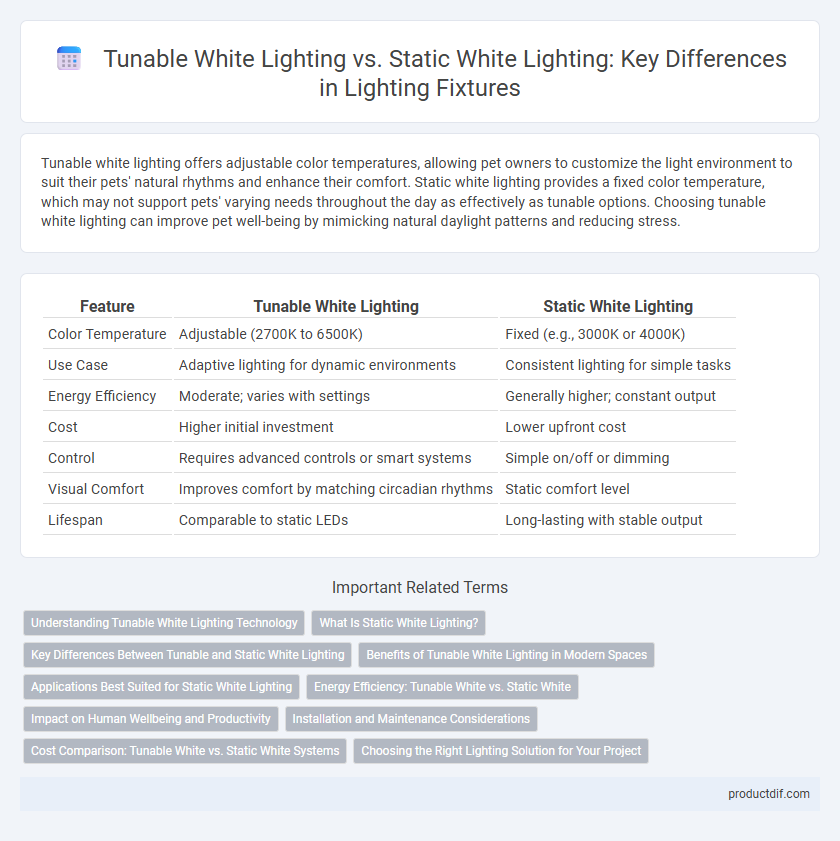Tunable white lighting offers adjustable color temperatures, allowing pet owners to customize the light environment to suit their pets' natural rhythms and enhance their comfort. Static white lighting provides a fixed color temperature, which may not support pets' varying needs throughout the day as effectively as tunable options. Choosing tunable white lighting can improve pet well-being by mimicking natural daylight patterns and reducing stress.
Table of Comparison
| Feature | Tunable White Lighting | Static White Lighting |
|---|---|---|
| Color Temperature | Adjustable (2700K to 6500K) | Fixed (e.g., 3000K or 4000K) |
| Use Case | Adaptive lighting for dynamic environments | Consistent lighting for simple tasks |
| Energy Efficiency | Moderate; varies with settings | Generally higher; constant output |
| Cost | Higher initial investment | Lower upfront cost |
| Control | Requires advanced controls or smart systems | Simple on/off or dimming |
| Visual Comfort | Improves comfort by matching circadian rhythms | Static comfort level |
| Lifespan | Comparable to static LEDs | Long-lasting with stable output |
Understanding Tunable White Lighting Technology
Tunable white lighting technology enables precise control over color temperature, ranging typically from 2700K to 6500K, allowing users to adjust light to mimic natural daylight cycles or create specific ambiance. Unlike static white lighting, which offers a fixed color temperature, tunable white systems use advanced LED arrays and smart controls to dynamically shift light output, enhancing visual comfort and supporting circadian rhythms. This adaptability improves user experience in environments such as offices, healthcare, and residential spaces by optimizing lighting conditions throughout the day.
What Is Static White Lighting?
Static white lighting provides a fixed color temperature, typically ranging from cool white (4000K) to warm white (2700K), without the ability to adjust or change hues. This type of lighting is designed for consistent illumination that meets standard visibility and ambiance needs in residential, commercial, and industrial settings. Static white fixtures are often favored for applications requiring stable color output and minimal complexity in control systems.
Key Differences Between Tunable and Static White Lighting
Tunable white lighting offers adjustable color temperatures ranging from warm to cool, enhancing ambiance and supporting circadian rhythms, whereas static white lighting provides a fixed color temperature without variability. The flexibility of tunable white lighting allows for dynamic control in commercial and residential spaces, improving visual comfort and productivity. Static white lighting is simpler and cost-effective but lacks the adaptive benefits of tunable white solutions.
Benefits of Tunable White Lighting in Modern Spaces
Tunable white lighting offers customizable color temperature that enhances occupant comfort and supports circadian rhythms in modern spaces. It improves productivity and mood by mimicking natural daylight variations, unlike static white lighting which provides a fixed color temperature. Energy efficiency and visual adaptability make tunable white lighting ideal for dynamic environments such as offices, healthcare facilities, and residential areas.
Applications Best Suited for Static White Lighting
Static white lighting is ideal for applications where consistent color temperature enhances visual comfort and performance, such as retail displays, corridors, and offices. It provides a stable, uniform illumination that supports activities requiring minimal color variation, ensuring accurate color rendering and reducing eye strain. Static white lighting fixtures are cost-effective and simpler to install, making them well-suited for environments with fixed lighting needs.
Energy Efficiency: Tunable White vs. Static White
Tunable white lighting allows dynamic adjustment of color temperature, optimizing energy consumption by matching light output to specific tasks and times of day, which can reduce unnecessary energy use compared to static white lighting. Static white fixtures operate at a fixed color temperature, often leading to over-illumination or inadequate ambiance, resulting in higher energy waste. Studies show tunable white systems can achieve up to 30% energy savings in commercial settings by adapting lighting conditions to real-time needs.
Impact on Human Wellbeing and Productivity
Tunable white lighting adjusts color temperature throughout the day to mimic natural daylight, supporting circadian rhythms and enhancing mood, alertness, and overall wellbeing. Static white lighting remains fixed in color temperature, which can cause eye strain and fatigue due to lack of adaptation to natural light changes. Studies show tunable white systems improve productivity by aligning with human biological cycles, while static white lighting may hinder cognitive performance in prolonged use.
Installation and Maintenance Considerations
Tunable white lighting systems require advanced controls and wiring, which can increase installation complexity and cost compared to static white lighting that uses simpler setups. Maintenance for tunable white fixtures involves regular calibration and potential software updates to ensure color accuracy, whereas static white lighting generally demands less frequent adjustments and straightforward bulb replacements. Selecting the appropriate lighting type should factor in the availability of skilled technicians and long-term maintenance capabilities.
Cost Comparison: Tunable White vs. Static White Systems
Tunable white lighting systems generally involve higher upfront costs compared to static white lighting due to advanced control components and multi-channel LED drivers. Maintenance expenses may also be elevated for tunable white systems because of their complex electronics and calibration requirements. However, energy savings and enhanced user comfort can offset initial investments over time, making tunable white solutions a cost-effective choice in dynamic lighting environments.
Choosing the Right Lighting Solution for Your Project
Tunable white lighting offers dynamic control over color temperature, allowing adjustment from warm to cool white light to suit different moods and activities, which enhances comfort and productivity in various spaces. Static white lighting provides a constant color temperature, typically chosen for its simplicity and cost-effectiveness in applications where consistent illumination is sufficient. Selecting the right lighting solution depends on the project's requirements for flexibility, ambiance, and budget constraints, with tunable white lighting favored in adaptable environments such as offices and healthcare, while static white lighting suits residential or retail spaces with fixed lighting needs.
Tunable white lighting vs Static white lighting Infographic

 productdif.com
productdif.com